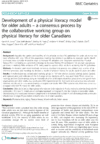Background
Arguably the uptake and usability of the physical activity (PA) guidelines for older adults has not been effective with only 12% of this population meeting the minimum guidelines to maintain health. Health promoters must consider innovative ways to increase PA adoption and long-term sustainability. Physical literacy (PL) is emerging as a promising strategy to increase lifelong PA participation in younger age-groups, yet there is relatively little evidence of PL being used to support older adults in achieving the PA guidelines.
Methods
An iterative and mixed-methods consensus development process was utilized over a series of six informed processes and meetings to develop a model of physical literacy for adults aged 65 years and older.
Results
A multi-disciplinary collaborative working group (n = 9) from diverse practice settings across Canada, and representative and reflective of the full range of key elements of PL, was assembled. Three consensus meetings and two Delphi surveys, using an international cohort of 65 expert researchers, practitioners, non-government organizations and older adults, was conducted. 45% responded on the first round and consensus was achieved; however, we elected to run a second survey to support our results. With 79% response rate, there was consensus to support the new PL model for older adults.
Conclusion
Older adults are a unique group who have yet to be exposed to PL as a means to promote long-term PA participation. This new PL model uses an ecological approach to integrate PL into the lifestyles of most older adults. Understanding the interactions between components and elements that facilitate PL will ultimately provide a new and effective tool to target PA promotion and adherence for all older Canadians.



Responses